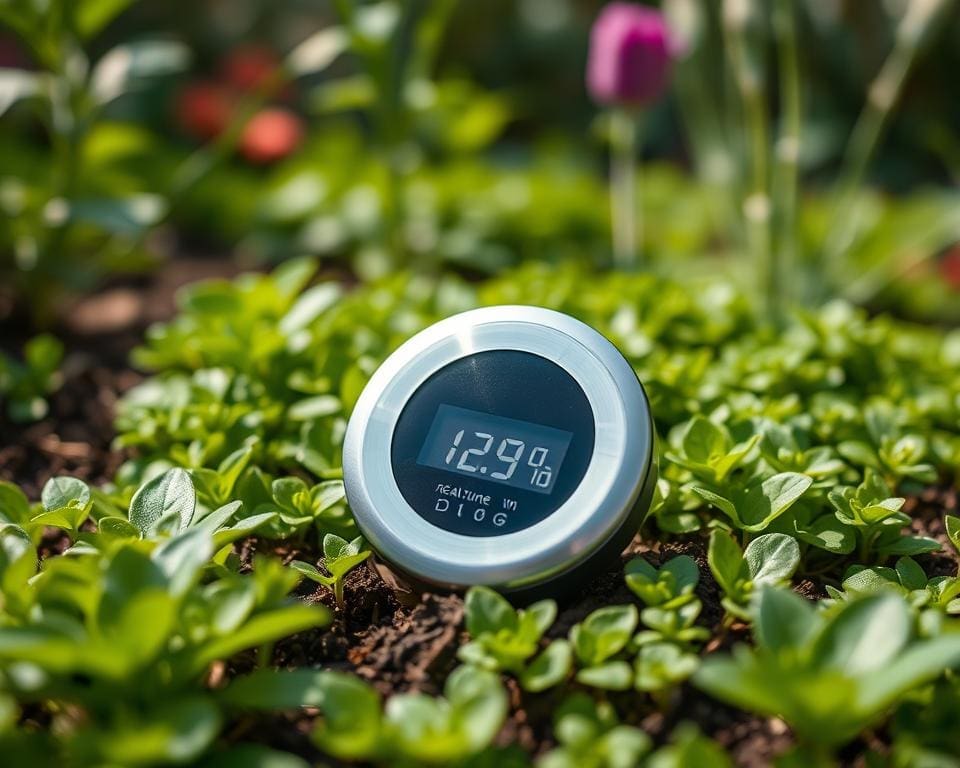A garden moisture sensor is an innovative tool designed to measure the moisture content in the soil, acting as a sophisticated moisture monitoring system. By providing real-time data, this device empowers gardeners to make informed decisions, optimising both plant health and resource usage. As gardening evolves in the face of climate change and water scarcity, the benefits of a garden moisture sensor become increasingly apparent. With its ability to prevent overwatering and ensure that plants receive the precise moisture they require, one must consider whether this essential addition to a gardener’s toolkit is a worthy investment.
Understanding Garden Moisture Sensors
Garden moisture sensors represent a significant advancement in gardening technology, enabling gardeners to maintain optimal soil moisture levels effortlessly. These devices operate by measuring the moisture content in the soil, ensuring plants receive adequate hydration without overwatering.
The two primary technologies used in these sensors are resistive and capacitive. Resistive sensors measure the electrical resistance between two probes, with higher resistance indicating drier soil. In contrast, capacitive sensors gauge the soil’s dielectric constant, offering a more reliable and accurate reading of moisture content. Different models cater to various gardening needs, making it easier for enthusiasts to select the right device.
Brands like Xiaomi and Ecowitt offer reliable models, such as the Xiaomi Soil Moisture Monitor and the Ecowitt Soil Moisture Sensor, both of which provide precise readings and user-friendly interfaces. By integrating these garden moisture sensors into daily gardening routines, individuals can make informed decisions about watering, leading to healthier plants and improved garden aesthetics.

Importance of Garden Moisture Sensors
The importance of garden moisture sensors cannot be overstated in modern gardening practices. These devices optimize irrigation efficiency, ensuring that plants receive just the right amount of water. Excessive watering can lead to water waste, a critical issue in an era of increasing environmental concerns. By monitoring soil moisture levels, gardeners can significantly reduce water usage while maintaining vibrant plant health.
Effective drought management is another significant benefit of using garden moisture sensors. As water scarcity becomes a pressing concern across the United Kingdom, these sensors provide invaluable data that guide gardening practices. They allow for precise control of irrigation systems, which conserves resources during dry spells and helps to sustain plant life when conditions become challenging.
Adopting garden moisture sensors aligns with a broader commitment to sustainable gardening. Statistics indicate that gardens can account for a substantial percentage of household water use. By integrating these sensors into irrigation practices, individuals can contribute towards combatting climate change and promoting environmental responsibility, making their gardening efforts both efficient and eco-conscious.
Benefits of Using a Garden Moisture Sensor
In the modern garden, utilising technology like garden moisture sensors brings numerous advantages that significantly enhance gardening practices. By understanding these benefits, gardeners can make informed choices that lead to thriving plants and efficient water use.
Enhancing Plant Health
The primary benefit of a garden moisture sensor lies in its ability to promote plant health improvement. These devices enable precise monitoring of soil moisture levels, ensuring plants receive adequate water without the risk of overwatering or underwatering. With timely and accurate watering, plants can flourish, leading to improved growth and yield. Many gardeners have reported noticeable vitality in their plants after implementing moisture sensors, which emphasises the positive impact these tools can have on overall garden productivity.
Water Conservation
Garden moisture sensors play a crucial role in effective water conservation techniques. By preventing excessive water usage, these devices help to establish sustainable practices that are vital in today’s environmentally conscious world. Through smart irrigation management, gardeners can reduce their water consumption while still maintaining healthy plants. Testimonials from garden enthusiasts highlight how integrating a moisture sensor has not only led to savings on water bills but has also supported local conservation efforts.
How Do Garden Moisture Sensors Work?
Understanding how to use a garden moisture sensor is vital for optimising your garden’s health. These devices are designed to monitor soil moisture levels, ensuring plants receive the right amount of water. Equipped with various components, they feature both hardware and software elements, collaborating to provide accurate readings. Gardeners can choose from different types of sensors based on specific needs and budgets.
Types of Sensors Available
When considering types of sensors, gardeners can typically select between wired and wireless models. Wired sensors often provide reliable readings and are perfect for larger gardens, while wireless sensors offer convenience, allowing for remote access to data. Additionally, within these types, there are budget-friendly options that deliver basic functionality, alongside advanced models equipped with sophisticated features and enhanced accuracy.
Data Interpretation and Monitoring
Data from garden moisture sensors is invaluable for effective gardening. Gardeners can easily interpret moisture levels through clear indicators, enabling them to adjust watering schedules accordingly. Some devices come with mobile applications that facilitate real-time monitoring, providing an effortless way to stay informed about soil conditions. These data monitoring tools empower gardeners to make educated decisions, leading to healthier plants and a more productive garden.
What is a Garden Moisture Sensor and Do You Need One?
Understanding what is a garden moisture sensor offers valuable insight into its role in modern gardening. This device is designed to measure the moisture level in the soil, providing essential data for making informed watering decisions. For many gardeners, the necessity for gardeners to incorporate such technology is grounded in the desire for healthier plants and a more efficient use of water resources.
Gardeners often cherish the fruits of their labour, but without appropriate moisture monitoring, plants may suffer. The benefits of moisture monitoring include optimising watering schedules, preventing over-watering, and ensuring that plants receive the right amount of hydration tailored to their specific needs. This device makes it possible to maintain an ideal environment, ultimately leading to thriving gardens.
Experienced gardeners often share anecdotes illustrating their transition towards using these sensors. As they adopt this technology, they notice a significant improvement in plant vitality and reduced water waste. The integration of a garden moisture sensor not only aligns with sustainable practices but also transforms gardening from guesswork into a more scientific approach.
Whether one is a novice or a seasoned gardener, understanding the crucial role of this device can inspire a deeper connection with the garden. Making a conscious effort to utilise technology yields advantages that benefit both the gardener and the environment.
Integrating Garden Moisture Sensors into Your Garden Irrigation System
Incorporating garden moisture sensors into your garden irrigation system can transform how you maintain your plants. These sensors provide vital information regarding soil moisture levels, allowing for smarter irrigation decisions that promote plant health and resource conservation.
Choosing the Right Garden Watering Tool
Selecting the appropriate garden watering tool is essential for successfully integrating moisture sensors. Consider pairing a reliable sensor with an irrigation controller or a smart water timer. This combination allows for precise adjustments based on real-time moisture data, ensuring your plants receive the optimal amount of water. Look for features such as:
- Compatibility with existing systems.
- User-friendly interface for easy programming.
- Customisable settings for different plant types.
Optimising Watering Schedules
Understanding how to adapt watering schedules based on sensor readings can significantly improve water efficiency. Moister soil calls for reduced watering while drier conditions may require more frequent irrigation. Tailor your schedules by:
- Monitoring moisture levels regularly.
- Adjusting watering habits according to seasonal changes.
- Factoring in plant species, as some may need more frequent watering than others.
Garden Maintenance Tips with a Soil Moisture Sensor
Incorporating a soil moisture sensor into your gardening toolkit can elevate your garden maintenance tips, helping to cultivate a thriving green space. Understanding moisture levels is essential, as it informs effective watering strategies and overall plant care.
Understanding Soil Moisture Levels
A soil moisture sensor provides vital data on the hydration levels within your garden soil. By monitoring these readings, you can determine whether your plants require more water or if they are adequately hydrated. Pay attention to the sensor’s feedback, which can reveal:
- When to water based on specific plant needs.
- How different soil types retain moisture.
- The frequency of rainfall effects on soil moisture.
Recognising these indicators allows for timely and informed decisions, ultimately supporting the health and resilience of your plants.
Adjusting Watering Habits
Using data from your soil moisture sensor enables you to make significant adjustments to your watering habits. Embracing this technology supports more sustainable gardening practices. You might consider:
- Watering early in the morning or late in the afternoon to reduce evaporation.
- Modifying amounts based on sensor readings, preventing over or under-watering.
- Creating a watering schedule that aligns with seasonal moisture fluctuations.
Aligning your watering routine with insights gained from the sensor leads to a healthier garden and makes efficient use of water resources.
Future Garden Technology Trends
The realm of future garden technology is rapidly evolving, offering exciting possibilities for enthusiasts and professionals alike. As smart gardening continues to gain traction, the integration of artificial intelligence into moisture management systems stands out as a key development. These innovative solutions can analyse environmental conditions in real-time, allowing for more precise irrigation based on actual plant needs rather than conventional schedules.
Moreover, the rise of automated irrigation systems, which rely on data from advanced moisture sensors, promises to enhance the sustainability of gardening practices. Such systems not only effectively conserve water but also improve plant health by ensuring optimal hydration. This shift towards automation signifies a broader trend in garden innovation—an embrace of technology that empowers gardeners to maximise productivity while being environmentally responsible.
Looking ahead, as these technologies become more accessible, they have the potential to revolutionise how we approach gardening. The future of gardening will likely see a harmonious blend of nature and technology, creating environments that are not only beautiful but also self-sustaining. Embracing these advancements in smart gardening will lead to a new era where every gardener, regardless of skill level, can cultivate thriving landscapes with ease.









